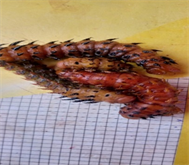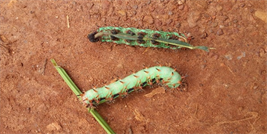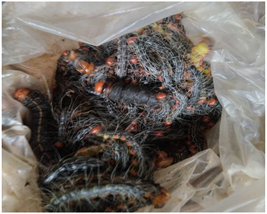1. Introduction
The utilization of insects as a sustainable and secure source of animal-based food for the human diet has continued to increase in popularity in recent years and edible insects live in a wide variety of habitats, from aquatic ecosystems to agricultural lands and forests [1] . Throughout the world, a large portion of the human population consumes insects as a regular part of their diet, and thousands of edible species have been identified [2] .
For most people living in rural areas, especially the poor, forests and trees are important sources of food and income. About 350 million of the world’s poorest people including 60 million indigenous peoples depend on forests for their daily and long-term livelihoods [3] . It is estimated that insects are part of the traditional meals of at least 2 billion people [4] . More than 1900 species are mentioned as human food [5] .
Insects have always contributed to the diet of many populations, on all continents and are a major source of animal protein for many communities and are essential for dietary diversification [6] [7] . More than two billion people mainly in Africa, Asia and Latin America feed on insects [8] . In addition to their food value, insects are a source of additional income for basic necessities including food, agricultural and school supplies [9] [10] .
In the Central African Republic, 95 percent of people living in the forest depend on insects for their protein intake [11] [12] . Until recently, insects appeared to be an inexhaustible resource harvested from nature. However, some edible species are now at risk. A number of anthropogenic factors, such as overexploitation, pollution, fires and habitat degradation, have contributed to the depletion of many species of edible insects. Indeed, the population reports the decrease, over the years, in the availability of the caterpillars that it consumes [13] . In addition, caterpillars of the Imbrasia genus are also traded regionally and internationally [14] . However, few studies have been carried out on caterpillars of the Imbrasia genus and their different plants with a view to the sustainable management of consumed caterpillars. For this reason, insect harvesting should be recognized as an important element in the pursuit of food security, if it is done in a sustainable way. To carry out a sustainable management strategy for edible insects, it would be interesting to study the interactions between these insects and their surrounding environment. It is in this perspective that this study on the interaction between edible caterpillars of the genus Imbrasia and their host plants in Boukoko.
2. Materials and Methods
2.1. Study Area
The Municipality of Boukoko (3˚54'00''N, 17˚56'00''E) is located on the northern edge of the Congolese forest basin and receives an average rainfall of more than 1600 mm of rain per year. The Municipality of Boukoko is characterized by a great diversity of natural areas and a rich biodiversity. The forest cover remains intact outside areas that have been assigned to other uses (agriculture, housing or administrative sites). It enjoys a hot and humid equatorial climate [15] . This type of climate has two seasons: a rainy season characterized by abundant rainfall which extends from mid-March to mid-November and a dry season shorter than the previous one, mid-November to mid-March. Rainfall, according to climatic data taken from the station of the Central African Institute for Agronomic Research (ICRA) in Boukoko, the minimum average is 1448 mm in annual water height and 2418 mm in height of water for the maximum average. Temperatures vary greatly from 25˚C to 28˚C. The annual thermal amplitude is 20˚C for the month of February and a maximum of 23˚C for the month of August [16] . The vegetation of the Commune of Boukoko presents the same characteristics as that of the South-West of the CAR. The evergreen dense humid forest poorly represented in the CAR is confined to the south, the most common species of this very humid dense forest are: Triplochiton scleroxylon, Terminalia superba, Entadrophragma cylindricum etc. which are large trees with huge trunks that sometimes reach 50 or 60 meters in height [17] .
The choice of this study area was based on the availability of insects as a food source; the entomophagy character of the riparian populations; the presence of insect-feeding plants and increasing deforestation.
2.2. Identification of Host Plants of Edible Caterpillar
Before exploring forest resources, the map and other general information of the Commune of Boukoko were obtained from the Town Hall of this Commune. The questionnaire was prepared and used as a tool for collecting information. The questionnaire was addressed to the actors of the collection and consumption of caterpillars in this Commune, to their local knowledge concerning this food resource as well as the plants of their locality on which caterpillars are collected. The survey took place in June to October 2022 and as a general rule, the 120 respondents were elderly people whose age range varied from 35 to 70 years old. Plant samples are collected in their natural environment. Based on local names; herbaria are mounted, plants photographed and samples collected. The scientific names were identified by herbalists from the Ministry of Water and Forests of the Central African Republic and Research Teachers from the University of Bangui. The illustrated flora of CAR [18] was used to confirm the species names.
2.3. Collection and Identification of Edible Caterpillars
The types of edible caterpillars have been inventoried in the field in collaboration with the local populations who consume them. Based on local names, the caterpillars are captured manually from morphological traits and then stored in bottles containing 70% ethanol. The specimens were identified at the Laboratory of Applied Animal Biology and Biodiversity of the University of Bangui using the identification keys [19] - [24] .
2.4. Statistical Analysis
The data was entered into the Excel spreadsheet which also made it possible to produce histograms with the frequencies of the plant species most valued by the different caterpillars. A Principal Component Analysis (PCA) was then performed using R software to highlight the correlation between caterpillars and host plants.
3. Results and Discussion
Eleven (11) local types of caterpillars consumed were listed by the population at Boukoko according to the different main host plants.
3.1. Main Host Plants of Imbrasia alopia
The leaves of Albizia ferruginea and Millettia barteri are the most cited as host plants of Imbrasia alopia while Milicia excelsa, Racosperma auriculiforme, Amphimas ferrugineus, Uapaca guineensis, Maesobotrya vermeulenii are the least cited host plants of Imbrasia alopia (Figure 1), Photo A1. According to [25] , Millettia barteri and Albizia ferruginea are the host plants of Imbrasia alopia.
3.2. Main Host Plants of Imbrasia anthina
The leaves of Aframomum alboviolaceum, Allophylus africanus, Ricinodendron heudelotii, Celtis gomphophylla and Manotes expansa are the most plants cited as host plants of Imbrasia anthina while Maesobotrya vermeulenii, Amphimas ferrugineus, Eribroma oblonga, Inga edulis, Pycnanthus angolensis, Ricinodendron heudelotii are the least cited host plants of Imbrasia anthina (Figure 2).
![]()
Figure 1. Proportion of plant species cited as host plants of Imbrasia alopia.
![]()
Figure 2. Proportion of plant species cited as host plants of Imbrasia anthina.
Similar works like those of [19] and [20] showed that Aframomum alboviolaceum, Allophylus africanus, Ricinodendron heudelotii, are the host plants of Imbrasia anthina in tropical America and Zambia.
3.3. Main Host Plants of Imbrasia eblis
The leaves of Manotes expansa, Chaetocarpus africanus, Dioscorea sp., Macaranga monandra, Erythrophleum ivorense and Allophylus africanus are the most cited as hosts of Imbrasia Eblis, while Lophira Alata, Millettia Laurentii, Rauvolfia Vomitoria, Uapaca Guineensis, Dichrostachys cinerea, Ricinodendron heudelottii are the least cited host plants of Imbrasia eblis (Figure 3), Photo A2.
The work done by [26] mentioned that Manotes expansa, Chaetocarpus africanus, Dioscorea sp. are vital plants of Imbrasia eblis.
3.4. Main Host Plants of Imbrasia epimethea
The leaves of Allophylus africanus, Petersianthus macrocarpus, Milicia excelsa, Albizia ferruginea, Ricinodendron heudelottii, Inga edulis and Pentaclethra macrophylla are the most cited as host plants of Imbrasia epimethea, while Entada abyssinica, Milicia excelsa, Entandrophragma cylindricum, Pycnanthus angolensis are the least cited host plants of Imbrasia epimethea (Figure 4), Photo A3.
These results corroborate with [27] who showed that Allophylus africanus, Petersianthus macrocarpus, Milicia excelsa, Albizia ferruginea are the host plants of Imbrasia epimethea.
3.5. Main Host Plants of Imbrasia forda
The leaves of Erythrophleum ivorense, Crossopteryx febrifuga, Macaranga spinosa,
![]()
Figure 3. Proportion of plant species cited as host plants of Imbrasia eblis.
![]()
Figure 4. Proportion of plant species cited as host plants of Imbrasia epimethea.
Rauvolfia vomitoria, Maesopsis eminii, Macaranga monandra and Pentaclethra eetveldeana are the most cited as host plants of Imbrasia forda, while Uapaca guineensis, Manotes expansa, Amphimas ferrugineus, Ficus sp. are the least cited host plants of Imbrasia forda (Figure 5), Photo A4.
The work carried out by [5] and [28] revealed that Crossopteryx febrifuga, Erythrophleum suaveolens, Macaranga spinosa are the host plants of Imbrasia forda.
3.6. Main Host Plants of Imbrasia melanops
The leaves of Macaranga spinosa, Rauvolfia vomitoria, Amphimas ferrugineus, Dioscorea sp., Pentaclethra eetveldeana, Albizia ferruginea are the most cited plants of Imbrasia melanops, while Amphimas ferrugineus, Ricinodendron heudelotii, Erythrophleum ivorense, Holarrhena floribunda, Ficus sp. are the most cited plants of Imbrasia melanops (Figure 6).
The work conducted by [17] in the CAR revealed that Macaranga spinosa is the host of Imbrasia melanops which is the subject of a worldwide revenue-generating activity.
3.7. Main Host Plants of Imbrasia obscura
The leaves of Maesopsis eminii, Pentaclethra eetveldeana, Albizia ferruginea, Macaranga spinosa and Amphimas ferrugineus are the most cited as plants of Imbrasia obscura , while Manotes expansa, Erythrophleum ivorense, Uapaca
![]()
Figure 5. Proportion of plant species cited as host plants of Imbrasia forda.
![]()
Figure 6. Proportion of plant species cited as host plants of Imbrasia melanops.
vanhouttei, are the least cited host plants of Imbrasia obscura (Figure 7), Photo A5. [28] documented that Pentaclethra eetveldeana and Macaranga spinosa are the host plants of Imbrasia obscura.
3.8. Main Host Plants of Imbrasia petiveri
The leaves of Amphimas ferrugineus, Rauvolfia vomitoria, Albizia ferruginea, Allophylus africanus, Manotes expansa, and Uapaca vanhouttei of Imbrasia petiveri, while Entada abyssinica, Uapaca guineensis, Entandrophragma cylindricum are the less cited host plants of Imbrasia petiveri (Figure 8).
These results are similar to [8] and [29] who showed that Amphimas ferrugineus, Rauvolfia vomitoria, Albizia ferruginea, Allophylus africanus are the host plants of Imbrasia petiveri.
3.9. Main Host Plants of Imbrasia truncata
The leaves of Petersianthus macrocarpus, Uapaca vanhouttei, Uapaca guineensis, Allophylus africanus, Amphimas ferrugineus, Celtis gomphophylla and Petersianthus macrocarpus are the most cited as host plants of Imbrasia truncata, while Pentaclethra eetveldeana, Petersianthus macrocarpus, Ficus sp., Ricinodendron heudelottii are the least cited host plants of Imbrasia truncata (Figure 9), Photo A6.
![]()
Figure 7. Proportion of plant species cited as host plants of Imbrasia obscura.
![]()
Figure 8. Proportion of plant species cited as host plants of Imbrasia petiveri.
![]()
Figure 9. Proportion of plant species cited as host plants of Imbrasia truncata.
[30] [31] on the species Petersianthus macrocarpus, Uapaca vanhouttei, Uapaca guineensis, Allophylus africanus, cited as host plants for edible caterpillars.
3.10. Main Host Plants of Imbrasia wahlbergii
The leaves of Celtis gomphophylla, Maesobotrya vermeulenii, Ricinodendron heudelottii, Maesopsis eminii, Pycnanthus angolensis, Allophylus africanus and Entada abyssinica are the most cited as host plants of Imbrasia wahlbergii , while Holarrhena floribunda, Pentaclethra eetveldeana, Erythrophleum suaveolens, Milicia excelsa, are the host plants less cited of Imbrasia wahlbergii (Figure 10).
[5] [9] and [32] founded that the Celtis gomphophylla, Maesobotrya vermeulenii, are the most host plants of Imbrasia wahlbergii.
3.11. Main Host Plants of Imbrasia oyemensis
The leaves of Entandrophragma cylindricum, Albizia ferruginea, Petersianthus macrocarpus, Maesopsis eminii, Funtumia africana and Inga edulis are the most cited as host plants of Imbrasia oyemensis, while Pycnanthus angolensis, Dioscorea sp., Macaranga spinosa, Erythrophleum suaveolens and Holarrhena floribunda are the least cited host plants of Imbrasia oyemensis (Figure 11), Photo A7.
![]()
Figure 10. Proportion of plant species cited as host plants of Imbrasia wahlbergii.
![]()
Figure 11. Proportion of plant species cited as host plants of Imbrasia oyemensis.
![]()
Figure 12. Principal component analysis highlighting the correlations between the different tree species according to the varieties of caterpillars listed.
![]()
Figure 13. PCA highlighting the correlation between the different caterpillar species.
The work of [32] and [33] revealed that Entandrophragma cylindricum is the host Imbrasia oyemensis which is also subject to regional and international trade.
3.12. Correlation between Edibles Caterpillars of Genre Imbrasia and Host Plants
The Principal Component Analysis (PCA) carried out to assess the variability between the different species of caterpillars according to their host plants shows that the first two axes F1 and F2 explain 27.34% of the overall variability (Figure 12 and Figure 13). The different variables along the two factorial axes are weakly correlated. The caterpillar species Imbrasia truncata, Imbrasia epimethea, Imbrasia obscura, Imbrasia petiveri, Imbrasia forda and Imbrasia alopia have more host plant diversity than the caterpillar species: Imbrasia melanops, Imbrasia eblis, Imbrasia anthina, Imbrasia wahlbergii and Imbrasia oyemensis.
4. Conclusion
Edible caterpillars of the genus Imbrasia are an important resource from a food point of view and they provide income to the populations involved in their trade. The caterpillar species Imbrasia truncata, Imbrasia epimethea, Imbrasia obscura, Imbrasia petiveri, Imbrasia forda and Imbrasia alopia have more host plant diversity than the caterpillar species: Imbrasia melanops, Imbrasia eblis, Imbrasia anthina, Imbrasia wahlbergii and Imbrasia oyemensis. In view of the results obtained, it would be interesting to include the host plants of the caterpillars of the genus Imbrasia in the development or restoration plan for degraded forests.
Annex

Photo A1. Larva of Imbrasia alopia (Kanga), Moalbaye, 2023.

Photo A2. Larva of Imbrasia eblis (Guégueré), Moalbaye, 2023.

Photo A3. Larva of Imbrasia epimethea (Sounga), Moalbaye, 2023.

Photo A4. Larva of Imbrasia forda (ndoudni), Moalbaye, 2023.

Photo A5. Larva of Imbrasia obscura (Guéguélé), Moalbaye, 2023.
![]()
Photo A6. Larva of Imbrasia truncata (Mbanga), Moalbaye, 2023.
![]()
Photo A7. Larva of Imbrasia oyemensis (Mboyo), Moalbaye, 2023.